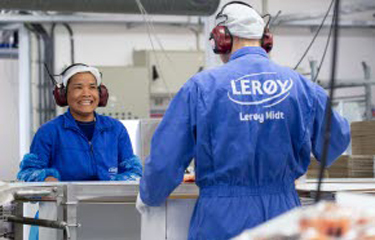Very strong market prices for seafood boosted Lerøy Seafood Group ASA (LSG) first-quarter 2022 revenues by 12 percent year-on-year to more than NOK 5.5 billion (USD 558.9 million, EUR 538 million), while its operating profit (before fair-value adjustments) climbed NOK 397 million (USD 40.3 million, EUR 38.8 million) to NOK 852 million (USD 86.6 million, EUR 83.3 million).
The Bergen, Norway-based seafood corporation’s Q1 2022 report stated that strong demand for seafood, including a substantial improvement in prices realized for the group's main products, was the most-important factor behind the improved earnings when compared with the same period last year. Even though its Q1 slaughter volumes of salmon and trout decreased by 10,000 metric tons (gutted-weight) from Q1 2021 to 32,057 MT, the company increased its earnings before interest and taxes (EBIT) from NOK 6.00 (USD 0.61, EUR 0.59) per kilogram to NOK 19.40 (USD 1.97, EUR 1.90).
"We have seen an extreme development in prices for seafood in the first quarter, in particular for salmon and trout. This development has been positive for earnings from farming and whitefish catches, but is a temporary challenge for earnings from the group's downstream operations," LSG CEO Henning Beltestad said.
LSG’s Farming segment (comprising its three Norwegian farming regions of Lerøy Aurora in Troms and Finnmark, Lerøy Midt in Nordmøre and Trøndelag, and Lerøy Sjøtroll located in Vestland) reported operating profit before fair value adjustment related to biological assets of NOK 621 million (USD 63.1 million, EUR 60.7 million) in the last quarter, compared with NOK 251 million (USD 25.5 million, EUR 24.5 million) a year previously.
According to the Q1 report, the average price for salmon in the three-month period was NOK 79.70 (USD 8.10, EUR 7.80) per kilogram, compared with NOK 59.70 (USD 6.07, EUR 5.84) in Q4 2021 and NOK 52.10 (USD 5.29, EUR 5.10) in Q1 2021. This constitutes a rise in price of NOK 20 (USD 2.03, EUR 1.96) per kilogram from the previous quarter, and an increase of NOK 28 (USD 2.84, EUR 2.74) kilogram from a year previously.
The price increases were not restricted to just the price of salmon, as costs across the business increased, Beltestad said.
"We are witnessing a very strong increase in costs for practically all input factors, with the price increases for feed the most evident. This will result in higher costs in 2022 when compared with previous years. At the same time, it appears so far that the increase in prices realized will be higher than the increase in costs," Beltestad said.
For the full-year 2022, LSG estimates a 2020 total salmonid harvest of 208,000 MT, including 23,000 MT from associates and its projected volume from Scottish Sea Farms' new acquisition, Grieg Seafood U.K.
Within LSG’s Wild-Catch segment, its subsidiary Havfisk's total catch volume was 25,116 metric tons (MT) in Q1 2022, compared with 25,721 MT in Q1 2021. Its primary species caught were cod (10,023 MT), haddock (7,441 MT), and saithe (3,510 MT). Compared with Q1 2021, its average selling price for cod increased by 46 percent, haddock was 24 percent higher, and saithe was up 37 percent.
Lerøy Havfisk had 10 trawlers in operation in the quarter.
While the catch value increased greatly, the segment’s profitability was negatively impacted by higher costs, including increased costs for crew and fuel. When compared with Q1 2021, total fuel consumption remained the same, but fuel prices were around 50 percent higher.
Along with Lerøy’s LNWS whitefish processing operations, the segment reported an EBIT of NOK 236 million (USD 24 million, EUR 23.1 million) for the opening three months of 2022, compared with NOK 185 million (USD 18.8 million, EUR 18.1 million) in the same period of 2021.
LNWS's primary business is processing wild-caught whitefish. The company has use of 12 processing plants and purchasing stations in Norway, five of which are leased from Lerøy Havfisk.
"High demand and lower quotas are key factors behind the positive development in whitefish prices. This provides a boost for earnings from the trawler fleet, but is a challenge for earnings from the land-based industry," Beltestad said.
LSG’s value-added, sales, and distribution division posted higher revenues of NOK 5.1 billion (USD 518 million, EUR 498.7 million) in Q1 2022, primarily due to higher demand in the period, the company said.
However, Beltestad said the increase seen in prices for seafood and transport costs in the first quarter were much higher than expected, which has put temporary pressure on margins for the group's downstream operations, and will have an impact on the company in Q2.
"At the same time, we have developed a strong and integrated value chain for seafood, and this remains stable with a good position for gaining new market shares during turbulent times,” he said. “The long-term outlook for own downstream operations has not changed."
Photo courtesy of Lerøy Seafood Group ASA







